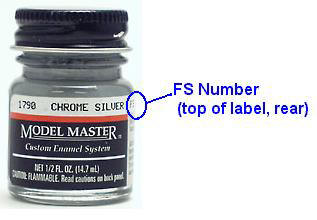![]()

Comparing colors online using
standard color references
British and Federal Standard colors
The British1 and Federal Standard color systems provide a means of comparing colors visually. By looking at a standard color chart on-line, itís easy to get a good look at a color you may be considering, and itís easy to discuss colors on-line in the Forum by referring to a standard that others can see.
The
American system has its origin in the military; and the British system, government and commercial use. By giving names to specific colors used, and then printing them on sample color chips, any paint manufacturer or paint contractor could identify and accurately mix a color. For example, in World War II, after December 1944 the new camouflage scheme for US naval ships was comprised of four very specific paint colors designated Navy Grey, Ocean Grey, Haze Grey, and Deck Grey.2The widespread applications in the military are the reason for the prevalence of military color names in many of the ModelMaster paint line, and to a lesser extent in other brands: SAC Bomber Green and British Gulf Armor Light Stone, for example. Both systems are now in use by their respective governments to specify both military and non-military colors Ė everything from post office trucks to lifeboats.
Any color in the British or American (Federal) system will also have a number, and itís actually the number that should be referenced. A colorís name may change over time, but the number will remain constant. Also, the Federal Standard colors have no official names; any names are common names that have evolved out of use. The number should always be referenced in either system, whether or not the name is used.
On a historical note - although the British system evolved in 1930, there is evidence that a number of existing colours were carried into the new system Ė including those in use by major shipping lines like White Star. This is the basis for the argument the Humbrol paint Light Buff is actually White Star Buff, or close to it. And while those holding to this opinion arenít in the majority, itís a good argument.
All ModelMaster paints derived from US military colors carry FS numbers. This provides a means to reference the exact color using on one of the websites below. The pages accessible through the additional quick-reference links at the bottom right of the page carry the FS numbers for ModelMaster paints, and for Humbrol, any paints with a direct FS equivalent. (These sites are also listed on the TRMA main Paint Reference page.)
Make sure not to confuse a paintís FS number with its manufacturer stock number. On ModelMaster paints, both are often shown on the label.
On-line access
Neither government
provides color references on-line. There are two reliable sites that
do,
however (these are the two links shown at the top of the page).
FS 595B:
http://www.ipmsstockholm.org/colorserver/
IPMS Stockholm website (Sweden): lookup of individual colors by FS number
BS 381c:
http://www.indfinspec.demon.co.uk/bs_381c_colour_chart.htm
Industrial Finishing Specialists website (UK): chart showing all
colours
Purchasing sets of the color standards
The British Standard system is more properly known as "British Standard 381c: Specification for Colours for Identification, Coding and Special Purposes", or BS 381 for short. The American system is more tersely called ďFederal Standard 595B: ColorsĒ, or FS 595B for short. Sets of each can be purchased from government-designated agencies:
FS
595B:
in the US,
available from the General Services Administration:
http://apps.fss.gsa.gov/pub/fedspecs/index.cfm
BS
381c:
in the UK,
available from the BSI Group:
http://www.bsi-global.com/Portfolio+of+Products+and+Services/Materials+Chemicals/Popularproducts/bs381c.xalter
How to read FS numbers
All FS numbers are 5
digits, and identify colors in this way:
1st digit: degree of reflectance:
1=full gloss Ė must reflect at least 80% of the light
2= semi-gloss Ė must reflect 30-45 of the light
3=lusterless (flat) Ė must reflect less than 8% of the light
2nd digit: base color (color group)

3rd/4th/5th digits:
1Information on British Standard Colours other than purchase info provided by TRMA member John Walker (thanks John!)
2Information referenced on naval camouflage colors is from the site http://www.shipcamouflage.com/index.htm. For any naval historian, this is a great site with photos, history, and for the modeler they sell historically accurate naval paint chip sets.
![]()